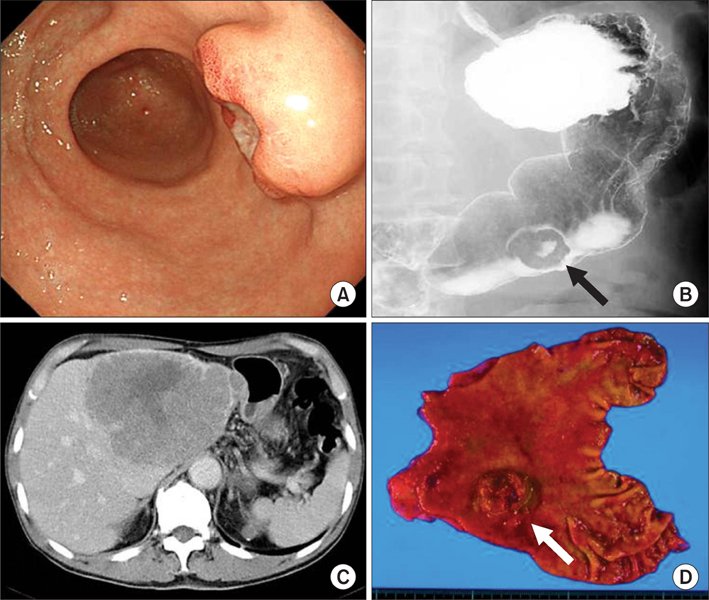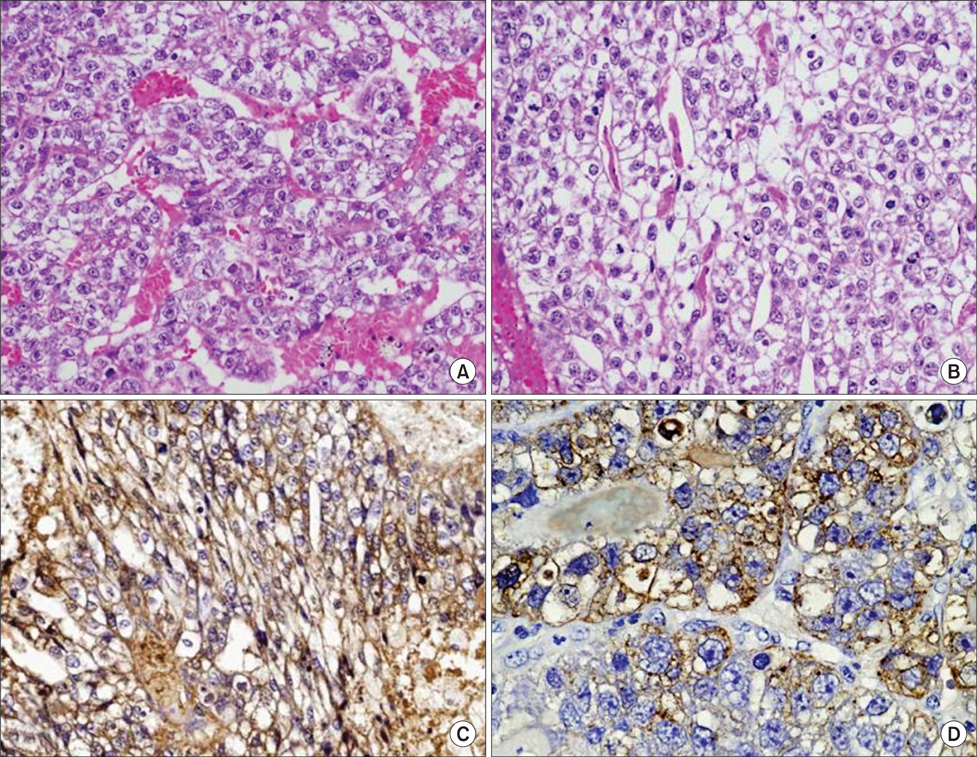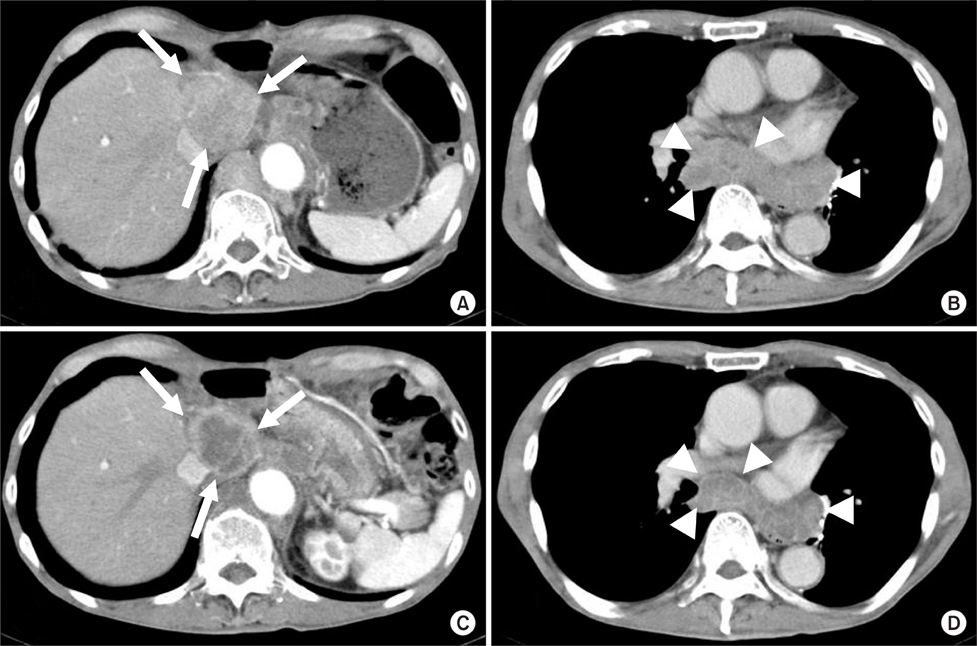J Gastric Cancer.
2013 Mar;13(1):58-64.
Five-Year Survival of Alpha-Fetoprotein-Producing Gastric Cancer with Synchronous Liver Metastasis: A Case Report
- Affiliations
-
- 1Department of Gastroenterological Surgery, University of Fukui, Fukui, Japan. koneri@hotmail.co.jp
- 2Cancer Care Promotion Center, University of Fukui, Fukui, Japan.
Abstract
- Alpha-fetoprotein-Producing gastric cancer is associated with poor prognosis because of frequent liver and lymph node metastasis. We present a case with synchronous liver metastasis who survived for 5 years. A 69-year-old man with upper abdominal pain was referred to our hospital. Gastrointestinal endoscopy revealed a Borrmann II-like tumor in the lower part of the stomach. Computed tomography revealed a tumor in the left lobe of the liver. Serum alpha-fetoprotein levels were markedly increased. We performed distal gastrectomy after administering oral tegafur/gimeracil/oteracil potassium and administered hepatic intra-arterial cisplatin injection. Liver metastasis showed partial response on computed tomography. Despite left hepatic lobectomy, further metastases to the liver and mediastinal lymph nodes became difficult to control. After sorafenib tosylate administration, stabilization of the disease was observed for 4 months. We conclude that hepatic intra-arterial chemotherapy and oral administration of sorafenib tosylate may potentially improve the prognosis in such cases.
MeSH Terms
Figure
Reference
-
1. Chun H, Kwon SJ. Clinicopathological characteristics of alpha-fetoprotein-producing gastric cancer. J Gastric Cancer. 2011. 11:23–30.
Article2. Kono K, Amemiya H, Sekikawa T, Iizuka H, Takahashi A, Fujii H, et al. Clinicopathologic features of gastric cancers producing alpha-fetoprotein. Dig Surg. 2002. 19:359–365.
Article3. Ishigami S, Natsugoe S, Nakashima H, Tokuda K, Nakajo A, Okumura H, et al. Biological aggressiveness of alpha-fetoprotein (AFP)-positive gastric cancer. Hepatogastroenterology. 2006. 53:338–341.4. Adachi Y, Tsuchihashi J, Shiraishi N, Yasuda K, Etoh T, Kitano S. AFP-producing gastric carcinoma: multivariate analysis of prognostic factors in 270 patients. Oncology. 2003. 65:95–101.
Article5. Kochi M, Fujii M, Kaiga T, Takahashi T, Morishita Y, Kobayashi M, et al. FLEP chemotherapy for alpha-fetoprotein-producing gastric cancer. Oncology. 2004. 66:445–449.
Article6. Inoue M, Sano T, Kuchiba A, Taniguchi H, Fukagawa T, Katai H. Long-term results of gastrectomy for alpha-fetoprotein-producing gastric cancer. Br J Surg. 2010. 97:1056–1061.
Article7. Asami T, Kokawa A, Sugimori K, Tomita N, Shirato K, Morimoto M, et al. A case of AFP-producing gastric cancer with multiple liver metastases responding to CPT-11 and cisplatin combination chemotherapy. Gan To Kagaku Ryoho. 2002. 29:1985–1988.8. Yoshioka M, Inoue N, Someda H, Noguchi M, Sawada M, Azuma K, et al. A case of AFP-producing gastric cancer resected after efficient S-1/CDDP combination chemotherapy. Gan To Kagaku Ryoho. 2011. 38:105–108.9. Sakurai N, Yamauchi J, Fukushima N, Shibuma H, Ikeda E, Sasou S. A case of non-recurred long-term survival after chemotherapy for liver metastasis of AFP-producing gastric carcinoma. Jpn J Gastroenterol Surg. 2005. 38:418–423.
Article10. Nagahama T, Maruyama M, Toukairin Y, Baba H, Yoshida T, Kure N, et al. Hepatic arterial injection therapy (HAI) for metastatic liver tumor from gastric cancer. Gan To Kagaku Ryoho. 2000. 27:1920–1923.11. Takada J, Kenno S, Aoki T, Hamada H, Katsuki Y. A case in which intra-arterial chemotherapy for simultaneous hepatic metastases markedly improved AFP-producing gastric cancer. Gan To Kagaku Ryoho. 2009. 36:2326–2329.12. Llovet JM, Ricci S, Mazzaferro V, Hilgard P, Gane E, Blanc JF, et al. SHARP Investigators Study Group. Sorafenib in advanced hepatocellular carcinoma. N Engl J Med. 2008. 359:378–390.
Article13. Kim C, Lee JL, Choi YH, Kang BW, Ryu MH, Chang HM, et al. Phase I dose-finding study of sorafenib in combination with capecitabine and cisplatin as a first-line treatment in patients with advanced gastric cancer. Invest New Drugs. 2012. 30:306–315.
Article14. Amemiya H, Kono K, Mori Y, Takahashi A, Ichihara F, Iizuka H, et al. High frequency of c-Met expression in gastric cancers producing alpha- fetoprotein. Oncology. 2000. 59:145–151.
Article15. Gao JJ, Inagaki Y, Xue X, Qu XJ, Tang W. c-Met: a potential therapeutic target for hepatocellular carcinoma. Drug Discov Ther. 2011. 5:2–11.
Article
- Full Text Links
- Actions
-
Cited
- CITED
-
- Close
- Share
- Similar articles
-
- Clinicopathological Characteristics of Alpha-Fetoprotein-Producing Gastric Cancer
- Alpha-fetoprotein-producing Gastric Cancer with Metastasis to the Scrotum: Case Report
- Clinico-Pathologic Characteristics of the Alpha-fetoprotein Producing Gastric Carcinoma
- A case of liver metastasis of gastric hepatoid adenocarcinoma
- Early Gastric Mucosal Cancer Associated with Synchronous Liver Metastasis






